Interview with Eva D. Papiasvili, PhD, ABPP,
IPA Co-Chair for North America, Inter-Regional Encyclopedic Dictionary of Psychoanalysis (IRED)
and Padma Desai, Editor Psychotherapist Associates Division of APsaA, E-Newsletter.
PD: Eva, how would you describe the Inter-Regional Encyclopedic Dictionary of Psychoanalysis (IRED) for our Psychotherapist Associates E-Newsletter readers?
EP: IRED is a result of a unique collaboration of more than 120 contributors from across all IPA regions, that combines both dictionary (definition of the concept) and encyclopedic (evolution of the concept) dimensions, where each entry is fully representative of all contemporary psychoanalytic perspectives, worldwide. It is posted on the IPA website and free to access, intended for all who teach, study, work and write using psychoanalytic concepts. We recently released a publicity notice on IRED on the APsaA Extended Listserv.
PD: This sounds like a great resource for our PA members. It is an enormous undertaking, what was the genesis of IRED?
EP: The idea was the brainchild of Stefano Bolognini, past President of the IPA and the current Chair of IRED and past Vice-President Alexandra Billinghurst, starting 2013. They had the vision to provide all psychoanalysts and psychotherapists across all mental health disciplines who work psychoanalytically with a comprehensive and authoritative international up-to-date resource, capturing how each concept evolved from Freud to the present time.
PD: So, this was something that did not exist before in a centralized way?
EP: Right, while there are many excellent regional dictionaries, IRED is unique in that it is fully representative of all theoretical trends and schools on a global scale. As such it is a universal tool for reference, education and consultation for any practitioner using psychoanalytic concepts.
PD: Given the depth and breadth of the vision, was initial goal about integration of concepts worldwide?
EP: The mission was not a forced integration of psychoanalytic concepts but rather a broad, complete representation across theoretical-historical-cultural milieu, with convergencies and differences clearly described, in respect to their theoretical specificity and richness of their historical and cultural background.
PD: What was the starting point to embark on this work and what was the methodology used to collect this information?
EP: We asked 25 consultants-psychoanalysts of varying theoretical and cultural backgrounds from Europe, North America and Latin America to answer two important questions: 1) which five concepts are most relevant in your thought and work and 2) which psychoanalytical concept originated in your psychoanalytic culture or has special resonance to it? The responses, containing general as well as regionally specific concepts, were then collected across the three regions and were arranged according to most frequently occurring concepts.
PD: What were the initial findings from this endeavor?
EP: We found the following concepts occurred most frequently and were most relevant in the first tier: Transference; Countertransference; (The) Unconscious, Containment: Container/Contained, and Projective Identification. In the second tier it was Object Relations Theories, Conflict and Nachträglichkeit; Among the regionally specific concepts there were Setting, Enactment, Self; Intersubjectivity. Many more entries are in the pipeline: IRED is a ‘work in progress’.
PD: Given the wide geographic representation and scope of IRED what are the overall findings to date?
EP: Over the past five years of constructing intra-regional and inter-regional entries for the IPA Inter-Regional Encyclopedic Dictionary (IRED), we have been continuously impressed by the phenomenon which we call “Migration and Mutation of Concepts”.
We found that concepts ‘Migrate’ in between the theoretical, linguistic and cultural groups and ‘Mutate’ when crossing the ‘in between zone’. This is most apparent when crossing (literally) the ocean, and arriving in the ‘New World’, but it is also perceptible in between psychoanalytic cultures within each continent.
PD: What is the current state of IRED at this time?
EP: Currently, IRED contains 13 tri-regionally finalized concept entries translated into ten languages so far and growing. In fact, IRED is currently the most frequently translated resource among all psychoanalytic dictionaries. There are many further concepts, regarded among most relevant to today’s psychoanalysts’ thought and work, in the pipeline.
PD: Lastly, what is the future going forward, how can IRED be the tool it was envisioned to be, a comprehensive resource for the psychoanalytical community?
EP: The goal is to keep expanding and building bridges across diverse psychoanalytical orientations worldwide. Because of its width and depth, IRED has been recommended by the IPA President Virginia Ungar to be included in the training curriculum of IPA-affiliated psychoanalytic institutes, as well as in current clinical and scholarly psychoanalytic publications as a vital up-to-date tool for consultation, research and reference.
PD: This is important work for the future of psychoanalysis. Eva, I want to thank you for sharing your work as IRED Co-Chair for North America. Our PA members can find more information on the IPA Inter-Regional Encyclopedic Dictionary of Psychoanalysis (IRED) e-book /flipping book at www.ipa.world. Members can also reach you regarding the above at the email listed below.

Eva Papiasvili, PHD
[email protected]

Padma Desai, LPC, LMHC
[email protected]
October, 2020